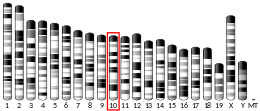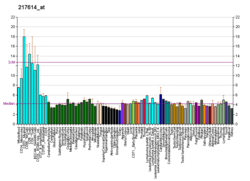HMHA1
Minor histocompatibility protein HA-1 is a protein that in humans is encoded by the HMHA1 gene.[5][6][7]
References
- GRCh38: Ensembl release 89: ENSG00000180448 - Ensembl, May 2017
- GRCm38: Ensembl release 89: ENSMUSG00000035697 - Ensembl, May 2017
- "Human PubMed Reference:". National Center for Biotechnology Information, U.S. National Library of Medicine.
- "Mouse PubMed Reference:". National Center for Biotechnology Information, U.S. National Library of Medicine.
- Wilke M, Pool J, den Haan JM, Goulmy E (Jan 1999). "Genomic identification of the minor histocompatibility antigen HA-1 locus by allele-specific PCR". Tissue Antigens. 52 (4): 312–317. doi:10.1111/j.1399-0039.1998.tb03053.x. PMID 9820596.
- Nagase T, Seki N, Ishikawa K, Ohira M, Kawarabayasi Y, Ohara O, Tanaka A, Kotani H, Miyajima N, Nomura N (May 1997). "Prediction of the coding sequences of unidentified human genes. VI. The coding sequences of 80 new genes (KIAA0201-KIAA0280) deduced by analysis of cDNA clones from cell line KG-1 and brain". DNA Res. 3 (5): 321–329. doi:10.1093/dnares/3.5.321. PMID 9039502.
- "Entrez Gene: HMHA1 histocompatibility (minor) HA-1".
Further reading
- van Lochem E, van der Keur M, Mommaas AM, et al. (1997). "Functional expression of minor histocompatibility antigens on human peripheral blood dendritic cells and epidermal Langerhans cells". Transpl. Immunol. 4 (2): 151–157. doi:10.1016/S0966-3274(96)80009-8. hdl:1887/2991. PMID 8843592.
- Aróstegui JI, Gallardo D, Rodríguez-Luaces M, et al. (2001). "Genomic typing of minor histocompatibility antigen HA-1 by reference strand mediated conformation analysis (RSCA)". Tissue Antigens. 56 (1): 69–76. doi:10.1034/j.1399-0039.2000.560109.x. PMID 10958358.
- Kaminski WE, Piehler A, Schmitz G (2001). "Genomic organization of the human cholesterol-responsive ABC transporter ABCA7: tandem linkage with the minor histocompatibility antigen HA-1 gene". Biochem. Biophys. Res. Commun. 278 (3): 782–789. doi:10.1006/bbrc.2000.3880. PMID 11095984.
- Gillespie G, Mutis T, Schrama E, et al. (2002). "HLA class I-minor histocompatibility antigen tetramers select cytotoxic T cells with high avidity to the natural ligand". Hematol. J. 1 (6): 403–10. doi:10.1038/sj/thj/6200065. PMID 11920221.
- Fujii N, Hiraki A, Ikeda K, et al. (2002). "Expression of minor histocompatibility antigen, HA-1, in solid tumor cells". Transplantation. 73 (7): 1137–1141. doi:10.1097/00007890-200204150-00022. PMID 11965046.
- Mutis T, Blokland E, Kester M, et al. (2002). "Generation of minor histocompatibility antigen HA-1-specific cytotoxic T cells restricted by nonself HLA molecules: a potential strategy to treat relapsed leukemia after HLA-mismatched stem cell transplantation". Blood. 100 (2): 547–552. doi:10.1182/blood-2002-01-0024. PMID 12091347.
- Strausberg RL, Feingold EA, Grouse LH, et al. (2003). "Generation and initial analysis of more than 15,000 full-length human and mouse cDNA sequences". Proc. Natl. Acad. Sci. U.S.A. 99 (26): 16899–16903. doi:10.1073/pnas.242603899. PMC 139241. PMID 12477932.
- Wilke M, Dolstra H, Maas F, et al. (2004). "Quantification of the HA-1 gene product at the RNA level; relevance for immunotherapy of hematological malignancies". Hematol. J. 4 (5): 315–320. doi:10.1038/sj.thj.6200318. PMID 14502255.
- Ota T, Suzuki Y, Nishikawa T, et al. (2004). "Complete sequencing and characterization of 21,243 full-length human cDNAs". Nat. Genet. 36 (1): 40–45. doi:10.1038/ng1285. PMID 14702039.
- Kotzampasaki EM, Spyropoulou-Vlachou MS, Kalofoutis C, et al. (2005). "Minor histocompatibility antigen HA-1 and HPA-5 polymorphisms in HLA-identical related bone marrow transplantation". Transplant. Proc. 36 (6): 1735–1738. doi:10.1016/j.transproceed.2004.06.007. PMID 15350465.
- Mommaas B, Stegehuis-Kamp JA, van Halteren AG, et al. (2005). "Cord blood comprises antigen-experienced T cells specific for maternal minor histocompatibility antigen HA-1". Blood. 105 (4): 1823–1827. doi:10.1182/blood-2004-07-2832. PMID 15498856.
- Harangi M, Kaminski WE, Fleck M, et al. (2005). "Homozygosity for the 168His variant of the minor histocompatibility antigen HA-1 is associated with reduced risk of primary Sjögren's syndrome". Eur. J. Immunol. 35 (1): 305–317. doi:10.1002/eji.200425406. PMID 15593299.
- Krishnan NS, Higgins RM, Lam FT, et al. (2007). "HA-1 mismatch has significant effect in chronic allograft nephropathy in clinical renal transplantation". Transplant. Proc. 39 (5): 1439–1445. doi:10.1016/j.transproceed.2007.02.066. PMID 17580157.
This article is issued from Wikipedia. The text is licensed under Creative Commons - Attribution - Sharealike. Additional terms may apply for the media files.





